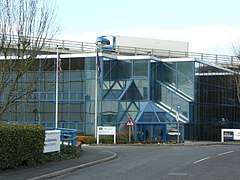Ultra Electronics
|
| |
| Public (LSE: ULE) | |
| Industry | Defence, security, transport and energy |
| Founded | 1920 |
| Headquarters | Greenford, London, UK |
Area served | Worldwide |
Key people |
Douglas Caster, Chairman Simon Pryce Chief Executive |
| Products |
C4ISTAR Cyber security Sonar systems Civil transport and energy systems and equipment Equipment for defence and security applications Military aircraft equipment Civil aircraft equipment Ice Protection Airport systems |
| Revenue | £775.4 million (2017)[1] |
| £61.5 million (2017)[1] | |
| £48.9 million (2017)[1] | |
Number of employees | 4,172 (2016)[1] |
| Website | www.ultra-electronics.com |
Ultra Electronics Holdings (LSE: ULE) is a British company serving the defence, security, transport and energy industries. It is listed on the London Stock Exchange and is a constituent of the FTSE 250 Index.
History
_and_Long_Wave_Bands%2C_4_Vacuum_Tubes%2C_Made_In_England%2C_Circa_1953-1954_(32487964883).jpg)
The Company was started by Teddy Rosen in 1920 as Edward E. Rosen & Co. manufacturing high quality headphones. In 1923 the company moved to new premises at Harrow Road, London and in 1925 a new company Ultra Electric Ltd. was formed. Ultra introduced its first mains powered wireless set in 1931. After further expansion the company moved to larger premises at Erskine Road, Chalk Farm, NW3 in 1932 and also built a new 150,000 sq ft (14,000 m2) factory at Western Avenue, Acton, W3 in 1935.[2] Ultra manufactured a wide range of domestic radio receivers including the Blue Fox, Lynx, Panther and Tiger models.[2] In 1939 Ultra presented a television receiver to the market for the BBC High Definition Television Service which was transmitted on 405 lines from the studios at Alexandra Palace, north London.[3]
During World War II the company diversified into building tails and bomb doors for the Short Stirling aircraft.[4]
Ultra opened a new factory at Gosport for the production of televisions and radios in 1956 and acquired Pilot Radio & Television in 1959, before splitting into two divisions, one dealing with domestic radio and television and the other with electronic products, in 1960.[5] In 1961 Ultra's consumer electronics interests became part of Thorn Electrical Industries, who continued to manufacture products using the Ultra brandname until 1974.[2] The remainder of the company became Ultra Electronics Ltd. - producing among other products the "Jezebel" and "Mini-Jezebel" sonobuoys[6] - which was bought by the Dowty Group in 1977.[7]
In 1993 Ultra was the subject of a management buyout[8] led by Julian Blogh[9] of seven Dowty Group plc companies which formed the Dowty Group Electronic Systems Divisions, which had been acquired by TI Group in 1992.[10] The company floated on the London Stock Exchange in 1996.[11]
Operations

The company works in the defence and aerospace, security and cyber, transport and energy markets, using advanced technologies. It is structured around three divisions: Aerospace & Infrastructure, Communications & Security and Maritime & Land.[12]
See also
References
- 1 2 3 4 "Annual Report 2017" (PDF). Ultra Electronics. Retrieved 30 March 2018.
- 1 2 3 Vintage Technology: Ultra Electric
- ↑ History of the BBC
- ↑ One firm's war Flight Magazine, 29 July 1960
- ↑ Ultra Electric Re-organisation Flight Magazine, 15 January 1960
- ↑ "Mini-Jezebel" (PDF). 26 November 1977. Retrieved 3 April 2015.
- ↑ Black Pig Ltd, The Sty, 47 Upper King St, Royston, SG8 9AZ, 01763 222 333. "Ultra Electronics". ultra-controls.com. Retrieved 3 April 2015.
- ↑ "Ultra Electronics Holdings plc Annual Report and Accounts 2005 Page 31" (PDF). Ultra Electronics Holdings plc. 2005. Retrieved 2006-09-25.
- ↑ Campbell, Katharine (1997-09-23). "'Pilot' with the right stuff: How three companies won acclaim in the Venturer of the Year awards". Financial Times.
- ↑ "British Engineering Merger Moves Forward". Reuters. 1992-06-11. Retrieved 2006-09-25.
- ↑ "Ultra Electronics Holdings plc Annual Report and Accounts 2010 Page 07" (PDF). Ultra Electronics Holdings plc. 2010. Retrieved 2011-04-19.
- ↑ "Ultra Electronics". FT. Retrieved 28 April 2017.